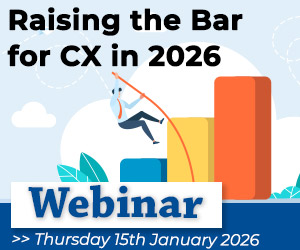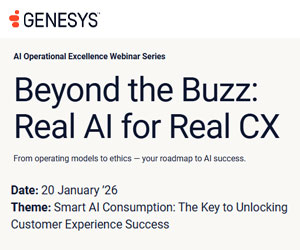We asked Peter Massey what call centre technology no one saw coming 30 years ago.
Quick Overview
The 5 technologies we cover in this article are:
- Social Networks
- AI
- Video
- Cybersecurity
- Dashboard and Analytics
The Future Comes Forward More Slowly Than One Thinks

When I was asked to write about five call centre technologies no one foresaw 30 years ago, I’m sure you’d expect me to write about surprises.
But I don’t think there are surprises – the lesson really is that known technologies take much longer than you think to go mainstream. As long as you keep your eyes wide open and continually develop your point of view, you can see what will be coming downstream.
Even quantum computing was foreseen 40 years ago, broke RSA encryption 30 years ago. Yet it’s only just now coming out of the shadows into the news, in an arms race breaking traditional encryption and creating new forms of security!
In March 1993 the FT started writing about the internet so it became common knowledge. The military research Arpanet had started in 1966.
I was using the academic network Janet in the 70s (quantum mechanics and fibre optic switching features later in history) and lecturing about TCP/IP, the basis of these and the internet, in the 1980s. You could have seen the impact of the internet coming if you looked.
But Have Any Technologies Had Surprise Impacts Since 30 Years Age?
1. Social Network
Our usage, even dependency, on search and social networks is not a surprise, and nor is the level of data which has been harvested. The fact we don’t care what data organizations hold about us is perhaps surprising.
2. Artificial Intelligence
AI has made enormous and quiet strides forward in terms of how it helps us in all the technologies in contact centres. In how proactively it analyses, identifies, notifies and fixes stuff.
Technology suppliers have been and are very careful to release what they have developed at a rate the public and press can absorb. Talking to machines has become normalized by Siri, Alexa and so on. In call centres it will be the norm.
3. Video
Augmented reality will perhaps be the next jump forwards. Seeing solutions presented in real time. But the biggest leap will be in personal ways of working through tools like ChatGPT and many specialist tools of this capability level.
4. Cyber Security
Security disasters like the Guardian recently suffered are few and far between. Investment in security technologies has stopped too many disasters in contact centres and organizations more widely – so far. The advent of quantum computing may test many of us in the near future. It’s an arms race.
5. Dashboard and Analytics
Dashboards and analytics have had deep impacts. Democratized solutions like PowrBiI or Tableau are letting people dig for themselves.
30 Years Ago Looking Forwards
So in 1993 we were starting to write and present about the internet and its foreseen and unforeseen impact.
The Situation 30 Years Ago:
1. You Need to Own Your Own Name
Register quickly, otherwise be ransomed.
2. The Internet Is Driven by Pornography
Enough said.
3. What Will You Do When the Phone Bill Is Zero?
This debate seemed utterly weird to most people, but it was an extrapolation of what happens when video, voice and data run for nothing at very high speeds brought about Moore’s Law in the exponential increase in computing power.
4. Dangerous Students Are Blowing Up Your Business Model Somewhere in the World
They don’t have the legacy systems and, more importantly, the legacy thinking of your industry. So they invent new business models with the latest technology.
5. Should You Cannibalize Your Own Revenue or Wait for the New Competition to Emerge?
This was the big question. Being first isn’t easy and being last is fatal. Timing is important, so experimentation is the right answer – lots of small, non-threatening experiments with new ways of working enabled by new thinking/technologies. Don’t bet the lot on one horse. Don’t be caught napping.
6. Inversion of Power From Sellers to Buyers
I drafted an article for HBR (darn, they never published it!) on inversion. How the internet’s key benefit would be to invert the way we did things.
We’d look for things rather than be targeted – well, only half right. Alan Mitchell’s book “Right Side Up” in 2002 and my colleagues’ book “Your Customer Rules” in 2015 exemplify this theme. We are now used to the fact that customers have better technologies than many businesses.
Points 2 to 5 still apply today in my view, regardless of which technologies have emerged.
All the points are still emergent and still apply. The point is to keep testing them for stealth or weakness, for pace of emergence.
What Hasn’t Worked Enough ?
- We need as much investment in psychology as in technology in any project if the technology is to have the desired impact
- Knowledge bases have been key to success in conversations in contact centres and online for a very long time. Yet the editorial and curation skills and resources are so underinvested.
- Contact centre leaders need optimization teams. So few have them, yet it’s a basic in online optimization. Less unnecessary contact rather than better contact has to be the aim.
Nostalgia for 30 Years Ago?
The punchline is that 30 years ago we’d just reached the point where every time you made a phone call it went through instantly and was crystal clear – oh, nostalgia!
And I’m still waiting for internet that works continuously and quickly at home, for a mobile phone network to fully cover where I live, my train route into London or to have throughput with a full signal.
If you liked this article from Peter, read these articles next:
- How to Embrace Serendipity
- Short Term Decisions vs Long-Term Consequences
- Complication Is Everywhere – Why Aren’t We Used to It?
- Everybody Needs Some Maths and Basic Stats
Author: Robyn Coppell
Reviewed by: Hannah Swankie
Published On: 23rd Jun 2023 - Last modified: 4th Sep 2025
Read more about - Technology, Peter Massey





































